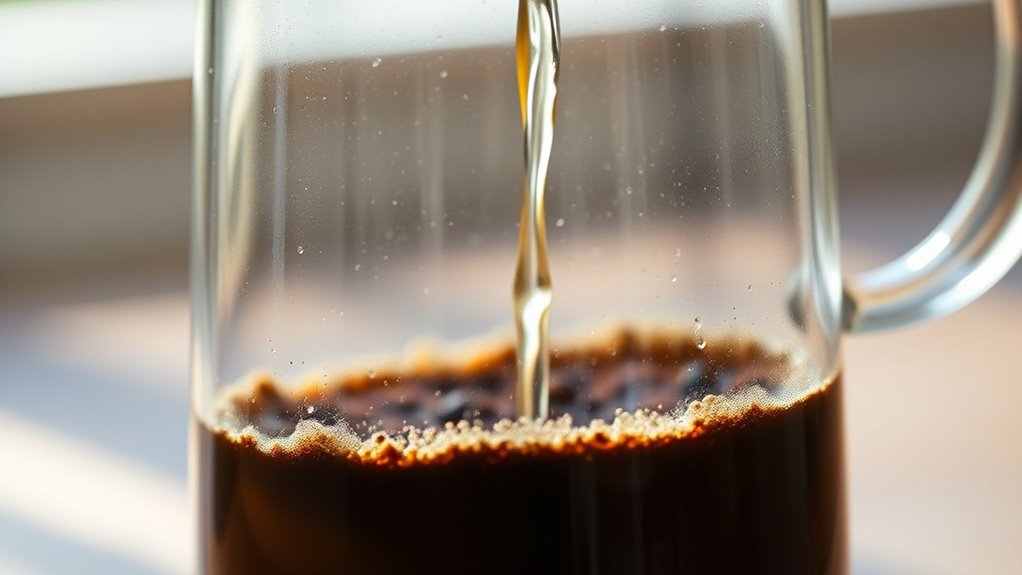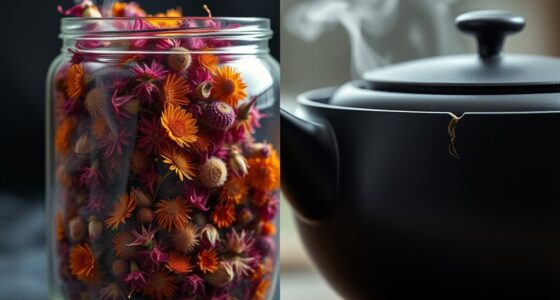Blooming is not strictly necessary when making French press coffee, but adding this step can help improve flavor extraction by releasing gases from the beans. To do this, you pour a small amount of hot water over the grounds, wait briefly, then add the rest of your water for steeping. While it’s not essential, trying out blooming might help you achieve a richer, more balanced cup—if you’re curious, there’s more to explore on this technique.
Key Takeaways
- Blooming in French press is optional; some argue it’s unnecessary due to full immersion during steeping.
- Blooming can help release gases from fresh beans, potentially enhancing flavor, but isn’t essential in French press brewing.
- Agitation during steeping may suffice for degassing, reducing the need for an initial bloom.
- Incorporating a bloom may improve extraction and flavor complexity, especially with freshly roasted beans.
- Personal preference and experimentation determine whether blooming benefits your French press coffee.

Have you ever wondered whether blooming French press coffee is necessary? It’s a common question among coffee enthusiasts, especially when trying to optimize their brewing techniques. The concept of blooming involves pouring a small amount of hot water over the coffee grounds at the start of the process, allowing gases trapped inside the beans to escape before the full brew. This step is often associated with pour-over or espresso brewing, but many wonder if it holds the same importance for French press methods.
In truth, blooming can *substantially* influence coffee extraction, which is the process of dissolving flavors, oils, and compounds from the grounds into your cup. When you skip this step, you might not be maximizing the potential of your coffee beans. The initial release of carbon dioxide during blooming creates a more even extraction during the full immersion phase. This means your coffee can develop a richer flavor profile, with more nuanced notes and less of the under-extracted bitterness that can result from uneven extraction.
However, whether blooming is necessary in a French press depends on your goals and preferences. French press brewing techniques differ from other methods because the coffee grounds are steeped directly in water for several minutes, providing a more uniform extraction. Some baristas and coffee experts argue that because the grounds are fully submerged from the start, the impact of blooming is minimal. They believe that the agitation during the steeping process is enough to release gases and promote proper extraction without an initial bloom.
Still, if you’re aiming for the best possible flavor, including a bloom can be beneficial. It’s a simple step that can improve overall coffee extraction, especially if you’re using freshly roasted beans that still release a lot of gas. To incorporate blooming into your French press routine, pour just enough hot water—about twice the weight of your coffee grounds—to saturate them evenly. Let this sit for 30 to 45 seconds, allowing the gases to escape, then add the remaining hot water and continue with your usual brewing steps.
Additionally, experimenting with blooming can help you better understand how different techniques influence the flavor profile of your coffee, enabling you to tailor your brewing process to your taste preferences. Ultimately, the choice to bloom or not comes down to your taste preferences and how much effort you want to put into perfecting your brew. While it’s not strictly necessary for a good cup, blooming can elevate your French press coffee by ensuring a more complete and balanced extraction. Experiment with and without blooming to see which method produces the flavor you prefer most.
Frequently Asked Questions
Can Blooming Improve the Flavor of All Coffee Types?
Blooming can improve the flavor of many coffee types by enhancing aroma preservation and boosting flavor. When you bloom coffee, you release trapped gases, which allows for better extraction during brewing. This process especially benefits freshly roasted beans, revealing more complex flavors. While not necessary for all coffee varieties, blooming generally leads to a richer, more aromatic cup, making your coffee taste fresher and more vibrant.
How Does Blooming Affect the Brewing Time?
Blooming slightly increases your brewing time, as you allow pre-infusion techniques to awaken flavors and aroma enhancement. When you pour hot water over coffee grounds, the release of carbon dioxide temporarily slows extraction, adding a brief pause. This extra step guarantees better flavor development, so you naturally extend your brewing process. Embrace the wait, knowing it boosts aroma and results in a richer, more vibrant cup.
Is Blooming Necessary for Cold Brew French Press?
No, blooming isn’t necessary for cold brew French press. The flowering process, which releases gases and enhances aroma, mainly benefits hot brewing methods. Since cold brew involves steeping coffee grounds in cold water for an extended period, the aroma enhancement from blooming is minimal. Skipping blooming won’t considerably impact your cold brew, allowing you to focus on steeping time and coffee-to-water ratio for the best flavor.
What’s the Ideal Bloom Duration for French Press?
Think of your coffee as a symphony waiting to unfold. The ideal coffee bloom duration for a French press is about 30 to 45 seconds. During this time, the coffee releases gases, enhancing flavor and aroma. This brewing enhancement guarantees your coffee develops a richer, fuller taste. Don’t rush this step; giving your coffee enough time to bloom makes all the difference in crafting a perfect cup.
Does Blooming Reduce Bitterness in French Press Coffee?
Yes, blooming can reduce bitterness in your French press coffee by releasing excess gases and allowing flavors to develop fully. When you bloom your coffee, you promote flavor enhancement, which creates a smoother, more balanced taste. This process helps mitigate harsh or overly bitter notes, resulting in a more enjoyable cup. So, taking the time to bloom your grounds can make a noticeable difference in the overall flavor and bitterness reduction.
Conclusion
So, do you really need to bloom your French press coffee? Absolutely, yes! Skipping this step is like trying to dance without music—you’re missing out on the full flavor symphony. Blooming releases explosive aromas, unleashes hidden flavors, and transforms your brew into a masterpiece. Don’t settle for boring, flat coffee—bloom it, love it, and elevate your morning to legendary status. Trust me, your taste buds will thank you forever.









